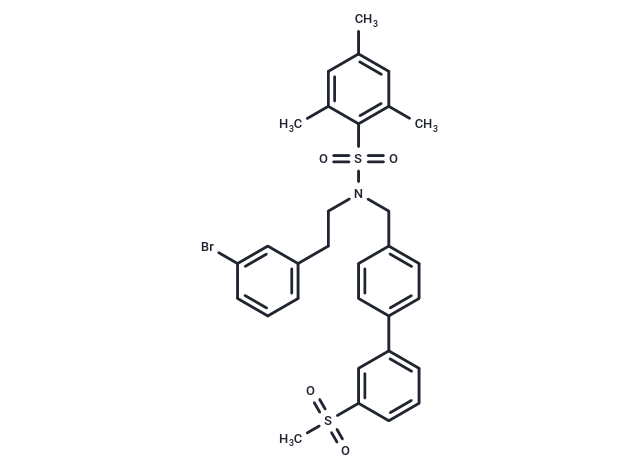Shopping Cart
- Remove All
 Your shopping cart is currently empty
Your shopping cart is currently empty

SR9243, an LXR inverse agonist, can induce LXR-corepressor interaction; shows anticancer activity and selectively targets the lipogenesis and Warburg effect.

| Pack Size | Price | Availability | Quantity |
|---|---|---|---|
| 2 mg | $32 | In Stock | |
| 5 mg | $51 | In Stock | |
| 10 mg | $72 | In Stock | |
| 25 mg | $126 | In Stock | |
| 50 mg | $197 | In Stock | |
| 100 mg | $363 | In Stock | |
| 200 mg | $575 | In Stock |
| Description | SR9243, an LXR inverse agonist, can induce LXR-corepressor interaction; shows anticancer activity and selectively targets the lipogenesis and Warburg effect. |
| In vitro | In HEK293 cells expressing LXRs, SR9243 inhibits LXR activation by enhancing LXR-corepressor recruitment. In a variety of cancer cell types, SR9243 reduces cancer cell viability, induces apoptotic cell death, and sensitizes cancer cells to chemotherapeutic treatments. [1] |
| In vivo | In Ob/Ob mice fed a high-fat diet, SR9243 (60 mg/kg, i.p.) inhibits LXR-dependent lipogenic enzyme gene expression and tumor growth. [1] |
| Kinase Assay | ALK5 Fluorescence Polarization Binding Assay: GW788388 binding to ALK5 is tested on purified recombinant GST?ALK5 (residues 198-503). Displacement of rhodamine green fluorescently labeled ATP competitive inhibitor by different concentrations of GW788388 is used to calculate a binding pIC50. GST?ALK5 is added to a buffer containing 62.5 mM N-(2-hydroxyethyl)piperazine-N'-2-ethanesulfonic acid (Hepes), pH 7.5, 1 mM dithiothreitol (DTT), 12.5 mM MgCl2, 1.25 mM 3-[(3-cholamidopropyl)dimethylammonio]-1-propanesulfonic acid (CHAPS), and 1 nM rhodamine green-labeled ligand so that the final ALK5 concentration is 10 nM based on active-site titration of the enzyme. The enzyme/ligand reagent (40 μL) is added to 384-well assay plates containing 1 μL of different concentrations of GW788388. The plates are read immediately on a LJL Acquest fluorescence reader with excitation, emission, and dichroic filters of 485, 530, and 505 nm, respectively. The fluorescence polarization for each well is calculated by the Acquest and is then imported into curve-fitting software for construction of concentration?response curves. |
| Cell Research | Cells are cultured in 96 well plates and treated with designated amounts of SR9243 for 96 hr in media containing 1% FBS and antibiotics. Cell-viability is assessed using the Cell-titre 96 kit according to the manufacturer's guidelines. Cell culture media is supplemented with oleate, stearate and palmitate dissolved in methanol to a concentration of 25 mM. 25 mM stocks are then diluted 10 fold in PBS containing 0.9% BSA. Lipid stocks (100X) are stored at ?20° until needed.(Only for Reference) |
| Molecular Weight | 626.62 |
| Formula | C31H32BrNO4S2 |
| Cas No. | 1613028-81-1 |
| Smiles | Cc1cc(C)c(c(C)c1)S(=O)(=O)N(CCc1cccc(Br)c1)Cc1ccc(cc1)-c1cccc(c1)S(C)(=O)=O |
| Relative Density. | 1.347 g/cm3 (Predicted) |
| Storage | Powder: -20°C for 3 years | In solvent: -80°C for 1 year | Shipping with blue ice. | |||||||||||||||||||||||||
| Solubility Information | DMSO: 20 mg/mL (31.9 mM), Sonication is recommended. | |||||||||||||||||||||||||
Solution Preparation Table | ||||||||||||||||||||||||||
DMSO
| ||||||||||||||||||||||||||

Copyright © 2015-2024 TargetMol Chemicals Inc. All Rights Reserved.